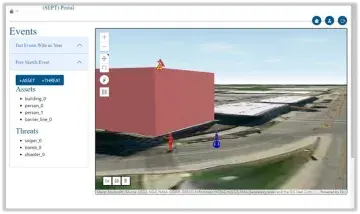
Anyone who has ever gone to a major sporting event or concert, taken public transportation, even visited a farmer’s market on a brisk weekend morning, has likely benefitted from soft target physical security—and perhaps didn’t even know it. This type of public safety precaution can take many forms, from blocked off roads with concrete barriers to checkpoints with metal detectors. It is an important part of protecting people every day as they go about their lives, as well as community infrastructure, but it can be a serious challenge.
The Science and Technology Directorate (S&T) is continuously working to equip those within the Department of Homeland Security (DHS) dedicated to securing soft targets with enhanced detection methods. Officials require the means to identify potential threats concealed in vehicles, on people, and in their belongings—while still maintaining personal privacy and not causing excessive disturbance to events or venues. S&T is developing layered and integrated capabilities for all of DHS that meet this public safety need. This includes a suite of decision-support software known as Special Event Planning Tools (SEPT).
“SEPT will be used to conduct security assessments and lead to a more comprehensive development for physical security planning,” explained Ali Fadel, S&T Soft Targets Security program manager. “The portal will reside behind a secure gateway and incorporate Personal Identity Verification access that will be available to all authorized users throughout DHS. The development is a modification of existing Department of Defense tools that have been adapted for use in civilian soft target and crowded place environments.”
SEPT is designed for Special Event Assessment Rating events level three through five, which require state and local support. (Event organizers submit details about their event to the DHS Office of Operations Coordination, which runs the analysis to determine the event rating.) DHS personnel and their regional protective security advisors will use SEPT to help local event organizers plan physical security for their event. The SEPT software suite was developed in partnership with the U.S. Army Corps of Engineers’ Engineer Research and Development Center (ERDC) and consists of both standalone and integrated risk mitigation applications that will assist public safety officials in making large-scale events as safe as possible.
One such application is SEPT’s Risk Management Tool (RMT), which enables users to assess potential event vulnerabilities and subsequent civilian consequences. Officials first identify which assets (i.e., the venue or nearest parking garage) are critical to the event and thus merit risk assessment and mitigation. They then define threats by selecting from potential threats like an active shooter or car bomb and choose the likelihood of such an attack occurring (minimal, low, medium, high, very high). The threats are then connected to the previously determined critical assets to create threat-asset pairs, which will be analyzed to determine the potential impact severity.
Next, users must define the vulnerability (how accessible the asset is to an attacker or other hazard) and consequence (potential for causalities) for each threat-asset pair. A risk score is then generated by the system along with a graph clearly depicting threat likelihood versus vulnerability and consequence. Crucially, the system also outputs suggested mitigation measures to reduce risk (i.e., introducing a security checkpoint). Once a risk reduction method is selected, the threat-asset pair is rescored based on the effect the mitigation has and the graph automatically updates to show how the attack’s probability and event vulnerability/civilian consequence are all reduced. A final risk analysis report can be generated to guide event planning with mitigation implementation and subsequently ensure public safety.

RMT data can be further leveraged through the Visual Event Planning and Risk Assessment (VEPRA) mapping tool. Another SEPT capability, VEPRA allows extensive scenario visualization through various modes, including satellite, street view, and outline. Users can add countermeasures, such as a concrete barrier and other assets like buildings, by clicking and dragging. The system creates a 3D model and similarly performs risk analysis functions based upon user inputs. For example, it is possible to see how the impact of a car bomb detonation on a major roadway near an event venue could be reduced by the introduction of a concrete barrier, as well as exactly how long that barrier should be and where it should be placed for maximum protection. The user can also add standoff distances and select different health concerns, like ear drum rupture or lung damage, to see how far the negative consequences of a hypothetical explosion would reach.
“You don’t have to be an engineer trained on blast fragmentation and other weapons effects in order to get a useful result from this very simple, but robust tool,” said ERDC’s Matt Hossley.
Next steps for SEPT include refining the software and cloning the code so it can be replicated within the DHS network. Developers will create user guides with sample scenarios to ensure the decision support tool can be implemented quickly and easily. It is expected to be rolled out for use by DHS headquarters and field personnel by the end of the year.

